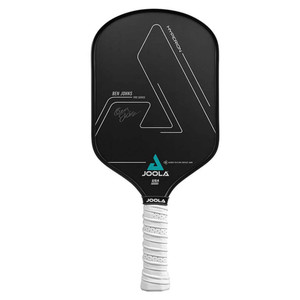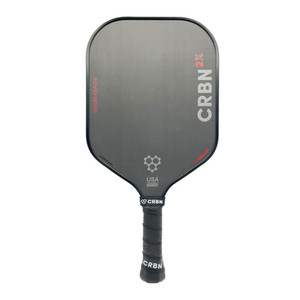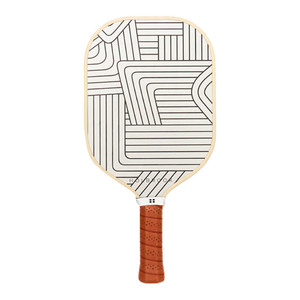

How to Improve Your Pickleball Game
So, you’ve gotten bit by the pickleball bug and you’re ready to take your game to the next level. The beginner paddle you started with, or the borrowed paddle from your friends, is no longer cutting it. We have listed here paddles that can help you take the next step. These paddles are designed to be easy to use and solid for the all-around game. They have power to drive and touch to dink with just the right amount of forgiveness. Our professional instructors and product specialists have come up with a selection of paddles to help get your game to the next level. Make a pick and hit the courts.How To Pick A Pickleball Paddle To Improve Your Game - Expert Advice from US Open & USAPA Nationals Champion Glen Peterson:
Okay, so you've been playing pickleball for a bit and want to take your game to the next level with a better paddle. Or perhaps you've made a resolution to jump into this sport and move up quickly and you want the perfect paddle to help you start. Our belief is this: If you are serious about your game, you should be serious about your equipment. Here are our thoughts on finding the best paddle to help beginner to intermediate players (2.5 – 3.5 rated) move their game along.When working with players who are interested in improving their game, our pros often get asked about what paddle they should use. To these players we recommend what I call a “game improvement paddle.” My definition of this type of paddle is one that is both forgiving and effective for all aspects of your game (serves, dinks, drops, and volleys.) I have been playing for eight years and have moved through nine different paddle models during this time, so don't necessarily think of this next paddle as the final paddle you will ever use.
Paddle Weight
So what's the big deal about an extra ounce in my hand? First, an ounce is about 15% of the paddle weight, which is a large incremental amount. You will feel a big difference between a 7.3 and an 8.3 ounce paddle. Secondly, that ounce is not centered in your hand but rather is some eight to ten inches away from your hand out on the paddle face. Because the handle becomes a lever giving leverage on the weight, this extra weight is felt much more. Third, ping pong paddles weigh about 3.0 ounces and tennis rackets weight about 10 ounces and athletes from these sports have concluded that weight is a huge factor and that starting light is wise.
The total weight isn’t the only factor, balance (or where the weight is located) matters as well. Some paddles are weight biased towards the head of the paddle, some are biased towards the grip, and some are balanced in the middle. Again, the leverage of the weight at the head of a paddle can make a paddle feel heavier, and cause you to exert more energy to simply move the paddle during a volley or from forehand to backhand. A “Head heavy” paddle take more strength to move around, puts more pressure on your joints and soft tissue, and reduces your hand speed in shot exchanges at the kitchen line. As a result, for a game improvement paddle I recommend selecting a paddle where that weight is balanced in the middle, or biased towards the grip.
Paddle Shape & Surface Area
The second consideration is shape and surface area. Paddles with wider (larger) faces are more forgiving when blocking and striking balls. The larger, more squared up surface area generates a larger more forgiving sweet spot. Balls don't come off consistently off the perimeter of paddles. Paddle “sweet spots” don’t extend all the way out to the edge of the paddle, and often stop one inch or more away from the edge. As such, narrow paddles end up creating paddles with a very narrow (thin) sweet spot, and players notice a big difference in how a ball feels when they don’t strike the ball exactly in the center of the paddle face. For game improvement paddles, I tend to recommend paddles where the ratio between the width and length of the face is closer, with paddle shapes that are less elongated. These wider shaped paddles create a larger, more circular and consistent sweet spot. These paddles are more forgiving when you mis-hit side to side on your paddle. I get asked often why paddles aren’t made both wider and longer. The reason is because the USAPA stipulates that the combined length (with handle) and width cannot exceed 24 inches. When I began playing, I was amazed at how many balls I actually hit by sheer luck off the back of my wrist. A paddle with a larger surface area is a luckier paddle because even balls I don't see well might get back over. And luck is a wonderful thing in pickleball. This is why I recommend more traditional, wider shaped paddle designs for beginners and people just moving up in the rankings (3.0 – 3.5 rating).
Some of you are wondering whether larger paddles are also heavier. Have I worked my way into a pickle by suggesting paddles that have both a large surface area face but are also light? Not really. Modern materials allow the world’s best paddle manufacturers to produce paddles that fit this profile, and the paddles on this page are available in these size and weight formats.
Paddle Grip
The third consideration is grip diameter and grip or handle length. As in other paddle or racket sports, starting with a smaller diameter grip generally encourages players to hold the paddle in a more relaxed way which is necessary to generate both power and control. Holding your paddle too tightly is referred to as a “death grip.” In my opinion, these death grips might also cause injuries. So start with a grip diameter 4.25 inches or under. Remember, you can always increase the diameter of your grip easily for just a couple dollars by adding an overgrip, so I recommend you start small because you can always go bigger later. As for grip (or handle) length, many players like to place a finger on the paddle surface for added control and paddle orientation; for these players, I recommend paddles with shorter handles which allows them to place their finger on the paddle surface without sacrificing much reach.
The fourth consideration is power vs control. While heavier paddles are generally more powerful, some lightweight paddles also have lots power. The goal at this stage of your game is not power but control. Consistency wins and is more fun for all involved. You can generate all the power you need at this stage of your game without a power paddle. Once you master control, then consider a more powerful paddle. Power vs Control is measured by how fast the ball comes off the paddle, and how consistent (or large) the sweet spot on the paddle is. I recommend players look for paddles with a large consistent sweet spot where they can control the ball and hit a predictable shot even if the ball is hit other than in the center of the paddle. Giving up a bit of power to have a larger sweet spot will reduce mis-hits, and give you more winning shots during match play.
To summarize my list of recommendations, game improvements paddles would include paddles that have a more traditionally shaped wider face (not blade or elongated shapes) and weigh less than 7.8 ounces with 4.25" or smaller diameter grips. They would be made from materials that create large consistent sweet spots, and bias the weight neutral or towards the handle, and have a shot feel that trades power for more control.
I’ve provided this list of characteristics to the product management team here at Pickleball Central, and the paddles on this page represent their recommendations of paddles that meet these criteria.
Q: How to get better at pickleball?
A: To improve in pickleball, consistently practice your shots, focus on your footwork,
and play regularly with players of varying skill levels. Additionally, consider taking
lessons, reading posts about pickleball, or watching instructional videos to refine
your techniques.
Q: How to win at pickleball?
A: To win at pickleball, it's essential to develop a strong serve, maintain a strategic
court position (especially near the net), and capitalize on your opponent's mistakes.
Good communication with your partner in doubles play is also key.
Q: How to hit in pickleball?
A: In pickleball, ensure you have a proper grip on the paddle, stand with a slightly
bent knees and ready stance, and use a combination of wrist and arm movement to
strike the ball. Aim for controlled, consistent shots rather than sheer power.
Click Here To Return To The Top Of The Page To Shop For Game Improvement Pickleball Paddles.





















